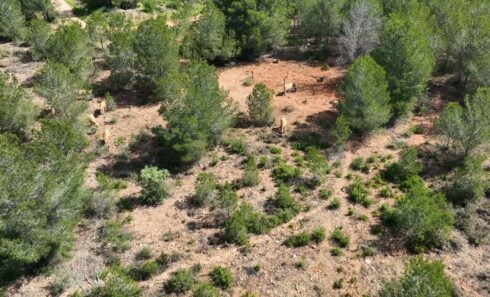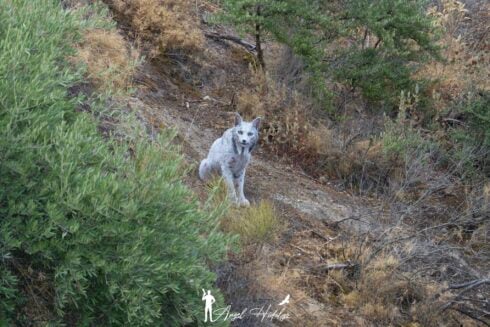Clive Muir and Sue Eatock go peering under rocks and stones to tell us all about the only protected spider in the EU – the Andalucian funnel web
IN Andalucía there lives a fairly large, black burrowing spider belonging to the venomous funnel web tarantula family. Its scientific name is Macrothele calpeiana and it belongs to the Hexathelidae group, which is normally associated with Australia, New Zealand, Asia, Central Africa and South America. There is one species known for the Mediterranean region (Walckenaer, 1805). The genus name is derived from Ancient Greek makro meaning big and thele, which refers to the spinnerets. The origin of the name calpeiana is from Calpe – a name the Phoenicians gave to Gibraltar.
This spider is known in Spanish as La Araña Negra de los Alcornocales, as within the Los Alcornocales Natural Park (Cadiz province) can be found the largest populations. Los Alcornocales is a forest of evergreen oak trees, mainly cork oak (Quercus suber) with its vast shady canopy creating an almost tropical feel. The temperatures and humidity levels in that area are more suited to these spiders’ requirements with a deep leaf litter for ease of burrowing.
Home sweet home
The first sign of their location is a silken white, sheet-like web anchored firmly to twigs, rocks, plants etc. This narrows to a tube near the centre, the entrance to the tunnel, which often leads to cooler depths underground. Although, there may be a labyrinth of several entrances to the one tunnel, the spiders are rarely communal.

The range of sites for these webs can be a simple scrape under a rock, vegetated banks, under logs, crevices in dry-stone walls, tree trunk bases and even tree hollows up to two metres above ground level. The underground portion can be to a depth of 80 centimetres, the upper part of which has a non-sticky web lining and the rest is left bare.
The day-time temperature at the burrow end can be 3 to 5 degrees Celsius cooler than at the entrance.
The Andalucian funnel-web spider is considered to be the largest in Europe and is easily recognisable. They are jet black with a glossy carapace and fine hairs on their legs and abdomen. The 1.5cm-long spinnerets, at the rear, almost look like extra legs. The body can be up to 3.5cm long and the stretched legs can reach a span of 8cm.
When under threat it can raise up its front legs into an attack position, exposing its fangs.
This is the only spider in Europe to be protected by the European Union Habitats Directive. They are found mostly in Cádiz and Málaga provinces with smaller numbers in scattered enclaves discovered in Huelva, Sevilla, Granada, Jaén, Gibraltar and the furthest north Badajoz, in Extremadura.
Two smaller communities found in North Africa are thought to be accidental imports from Spain. Further reports of their existence on the French side of the Pyrenees have been put down to their being carried with Olive trees and such. However, they are unlikely to survive cold winter temperatures.
Hunters
These spiders are most active at night when they will wait at the tunnel entrance for prey to become glued onto the silken web. Their diet consists of small insects such as beetles, woodlice, millipedes and crickets.
When they feel the vibration of a trapped insect they will carefully approach, then bite the ill-fated prey with venom, which liquefies the victim as it is wrapped in silk. The venom is injected into the prey through openings in the tips of the pair of fangs. The glands that produce this venom are located in the two segments of the chelicerae (the parts to which the fangs are attached). “Dinner” is then taken into the private and protected retreat area behind the web to be devoured.
After eating they are fastidious cleaners. Any food debris will be discarded away from the web and around an hour of thorough grooming will follow.
Around April-May time, males wander around at night in search of a female with which to breed. It is thought there are pheromones in the silk of a female’s web that attract a mate. A gentle courtship ensues, as the male does not want to become the next meal.
The female then eats more over the ensuing weeks.
In early July, she seals herself into the retreat in order to produce the egg sac.
The females care for the egg sac by carrying it with them, manoeuvring to different parts of the tunnel to maintain the right levels of temperature and humidity.
The young have their first moult within the sac and she then helps to release them using her fangs. Possibly 100 to 250 eggs will hatch into baby spiders, known as spiderlings. They will accompany the female to the outer web after dark and are thought to feed on smaller prey.
At some point cannibalism among the young may occur, triggering dispersal of the survivors. At this point, many of the young will fall prey to other animals.
As they prefer little disturbed areas and are active at night, you will not normally encounter these spiders. Be cautious if you are moving logs, rocks etc and see a sheet like web. If provoked these spiders will rear up in a threatening manner and can even give an audible hiss. A famous close relative is the Australian funnel-web (Atrax robustus), whose bite can be fatal. Macrothele calpeiana venom is mild in comparison giving localized but painful swelling.
Clive and Sue launched wildsideholidays.com as an advertising medium for ethically-minded nature holiday businesses in Spain. The aim is to provide an internet site on which people searching for this type of holiday can easily find what they are looking for.
Together with iberianature.com, wildside holidays also run the iberianature forum (www.iberianatureforum.com) – the best online resource for learning about the nature of Iberia.
Click here to read more News from The Olive Press.







Just had a house built in Velez Rubio. Near a pine forest and in scrubland. Found two of these lads in two days on the outside path around the house. Seemed to be sleeping or resting. After touching them (with a long pole) they reared up as noted above, but seemed to be in protective mode and weren’t otherwise aggressive. Lots of webs in the heather around the land.
Hi John,
They will be quite happy living in the woods and I have never known them to go out of their way to attack anyone. Always they rear up in self defence.
Things to avoid are nooks and crannies around your house walls. Things like log piles heaps of bricks etc.
When you find one where you don’t want it just catch it in a big glass or get it on a shovel and deposit it a few hundred metres away. We put the ones we find in stone walls that won’t be touched again or sometimes across the other side of the stream by our house…
Best regards and thanks for your comments…
Clive (Wildside)
Just found two of these beauties outside our house today 6/12/07 in Monda.
It looked like they had paired up underneath a bin bag of leaves that had been there three days !!
Is it mating season in December ?
Regards
Andy
Hi Andy,
Were they big adults the two you found? A nice warm place under some leaves in a bag would make a great place for these spiders to spend the winter. They wouldn’t have been breeding at this time of year though.
Around April-May time, males wander around at night in search of a female with which to breed. It is thought there are pheromones in the silk of a female’s web that attract a mate. A gentle courtship ensues, as the male does not want to become the next meal.
The female then eats more over the ensuing weeks.
In early July, she seals herself into the retreat in order to produce the egg sac.
The females care for the egg sac by carrying it with them, manoeuvring to different parts of the tunnel to maintain the right levels of temperature and humidity.
Clive
Hi
We have just moved back to Gibraltar with our dog and while sweeping out the patio area we moved a few pieces of wood and out came one of these Funnel spiders. We cant seem to find anywhere that will tell us if they bite and how deadly they are if at all. Does anyone Know?
Hi Mark,
Yes, they will bite if handled and a dogs nose poking in a corner may well be a target…
The bites can be painful but not deadly. I suppose that an allergic reaction could take place so a bite from this spider could be as deadly as a bee sting depending on the person bitten…
The best way to keep these spiders at a distance is to keep the area around your house free from nooks, crannies and woodpiles etc.
http://www.wildsideholidays.com/natural/insects-and-creepy-crawlies/91-spiders-etc/71-andalucian-funnel-web-spider
Clive
Hi folks,
My daughter has just come over to visit us in Giraltar an this morning whilst walking down stairs stepped on one of these spiders! We think it is a male, about 10-12cm, though it lost a leg it was still alive and displayed the classic defensive posture. At the time we were not sure what it was so took it to the GONSH people in Almeda Gardens, who confirmed it – and said it was a pretty big one too – The scream from my daughter, at the time, nearly gave us all a heart attack!
we came across one of these this week. as you say, rocky nook and cranny, while doing a bit of hard work in the garden. we are about 15 kms up the coast from Gib. Didn’t realise we had to watch for these – first one we have seen – but we normally are on the watch for Megarian Yellow Banded Centipedes. They grow to about 12-15 cms, like dark damp hideyholes and have a bite like a scorpion, not fatal but can hospitalise you with the pain apparently. Local people have no hesitation in killing them instantly.
Hi all, whilst living in Malaga provence in 1999 my housemate came across one hiding behind a bin in the house. My friend asked if I was good with spiders to which I replied in the affermative but was completely astounded when I found this one because it was huge. I didnt realise that these spiders were protected and at the time I didnt know if they had a seriously dangerous bite or not, so I placed a glass on top of it (we also had two dogs who were rather interested in it and i didnt want them getting bitten) by the next morning the spider had unfortunately perished. I was upset by this fact because I dont like to kill other life without proper reason and also I believe it is bad luck to kill a spider in the house. A couple of weeks later (during which time I barely slept because of fear) I found what I believe to be its young in the house. I take it that both the mother and its baby were hibernating for the winter or something to that effect. I didnt have enough spanish at the time to find out more about this spiders bite and its habits and unforetunatly both spiders where killed by me and my ignorance.
Hi, I have found one of these webs with a resident amongst the undergrowth of my lavanda plants. I need to move it as its at the entrance of a footpath and i also have 2 pet dogs. any suggestions on how to move it? i am 29kms inland from velez malaga.
I was bitten on the forehead above the left eye by this spider in Estepona,Malaga,Spain. I am not sure exactly when but
probably while moving pine logs.on Sat 12th Dec 2009.It began to swell on the Sunday and the following Monday I went to see the “Radio Host Dr Nigel Lewis”. We didn’t know what had bitten me and as an initial cure he perscribed 1 Doxiclat 100mg pill per day. Two days later the wound had grown and spread to the head and down to the glands below the jaw.I have experienced mild headaces’and considerable discomfort.I went to the Dr and the perscription was increased to 2 Doxiclat 100mg pills per day and a Penecilin pill called Cellor 500mg 3 X per day and Ibrufen 600mg 3 x per day.The pain and swelling have remained constant and if anything have increased 1 week later and I am advised that the ugly mark on my face will probably not heal well, leaving a type of scar.
Sept 2010. The scar the bite left is still very visible, but other than that the wound healed within 2 months.
MB
nov. 2010 in cadiz. found it in the shower web was in the wardrobe corner.
We were horrified when we found a couple of these in our swimmingpool here in Fuengirola (July 2012). Two families with small kids living here, so I would very much like to get rid ASAP! Huge spiders (approx 6cm body) are not very popular guests having around. Any tips how to remove these? Should we remove the olive trees in the garden?
Alright, that’s it! Found another giant sitting by our feet as we were sitting outside our house. Is there anyone we can contact in order to get these removed? Anyone?
Kjetil, are you really as daft as you sound? The area outside your property is called the “outside world”. Spiders, ants, centipedes and every other insect known to man inhabit this place. Cutting down trees will not remove insects. So what if you have young children and guests about? Humans and insects have always lived side-by-side, and will continue to do so for the forseable future. Leave them alone, and they’ll leave you alone. And don’t harm them; they’ll come back and get you…
So if a venomous snake was sitting on your porch every night, while you were having friends over for a party, you wouldn’t try to relocate it because it naturally belongs in your region? Don’t be stupid.
Now you’ve gone from arachnids and insects to snakes lol. What has cutting down trees got to do with ‘relocating’ such creatures? Imagine how busy you’d be if you had to get someone in to remove every spider, snake and centipede. For goodness sake, talk some sense. Go and cut doen your garden and see if that helps.
Did I originally bring up any other specimen than spiders? No, you did.
If you don’t wanna help, then head for a very hot place. I’ve found their hiding place btw. Yep, it’s below the olive tree. consider it gone.
Quote: “So if a venomous snake was sitting on your porch every night”
Duh.
Quote: “Spiders, ants, centipedes and every other insect known to man inhabit this place…Humans and insects have always lived side-by-side, and will continue to do so for the forseable future.”
Return to your insect books, geek.
I hope you didn’t kill it, they are a protected species. Personally, I’d rather eradicate you than the spider. Karma calls…
Calm down boys!!!
We’ve had four of these in the past weak, one of which was in the swimming pool and slowly revived once removed. We live on a mountain in South Valencia. The one found today was residing behind a stack of plant pots in a secluded part of the garden. It certainly gave a hiss when I picked up the pot and as it was dangling from a web I presume I disturbed its funnel. I put it down on a rock and it reared up. Scary looking blighters!
Thanks for the info. as I have found a couple of these in the last 6 months while landscaping our patch of land around our cortijo near Montefrio, Granada. I’m pleased to say that an environmentally aware childhood taught me to put the rock back down again and let them get on with life. Nice to know what they are though, even is a lot scary at first sigth :)
Have just found a web of the funnel web spider covering a lowish bush near the front door. I live just south of Alicante city and while I too value wildlife I am sorry but I just cannot have it there. We have pets and grandchildren. It wont even just stop at one spider, we could end up with loads. It has to go, advice very welcome.
There was one hiding under my son’s buggy when we were on holiday in velez rubio. Impressive, we took a photo.
When I was serving in Gibraltar 50 years ago with the RAF the spiders were a considerable problem. We liked to keep the base clean and tidy but local gardeners were very reluctant to clear out any accumulations of leaves or litter for fear of being bitten.
I live in the acornocales natural park and have recently started using what used to be an attic with wooden beams. There are spaces between the beams and ceiling which I’ve noticed in the past couple of weeks have webs that look like funnel web spider webs. Would they live so high (1st floor)? I have seen quite a few webs in the garden but just stay clear but in the house is a different matter as I have 2 babies under the age of 2 and there were 2 webs above the cot! Could this be another spider as it gets pretty hot up there? I have been bitten by some spider or other twice whilst on the sofa and had to have anti allergy shots as they have been so bad. Any info would be greatly appreciated as worried for the babies.